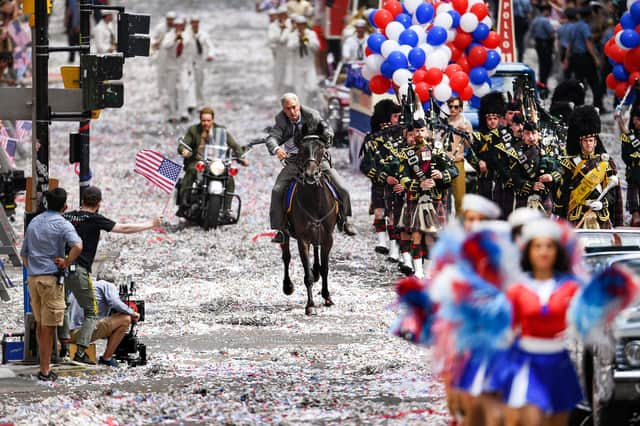Indiana Jones and the Dial of Destiny: Film industry may discover that immortality for actors is no Holy Grail – Alastair Stewart


Indiana Jones and the Kingdom of the Crystal Skull was released in 2008 to polarised reviews. Disney and Hollywood's obsession with reviving legacy characters has been chequered at best in the years since, and things are getting stranger. The trailer for the fifth movie, Dial of Destiny, features the 80-year Harrison Ford wielding a whip and donning a fedora once more. Only this time, his younger self joins him in some time travel hijinks. And cue the head-scratching.
Ford reputedly plays two Indiana Joneses, in middle and older age, for most of the movie. And while the plot may sound as if the beloved adventure series has jumped one shark too many, the impressive de-ageing special effects will surely be a seminal moment in cinema history. Gone is the dodgy screen double wearing a facsimile wig. Goodbye to the squint-and-you-see-it recast actor. Thanks to visual effects company Industrial Light & Magic and the new VFX technology from Disney, heroes are now essentially immortal.
Advertisement
Hide AdAdvertisement
Hide AdLike with all technological breakthroughs, the question fast becomes if we should celebrate or cower. Making actors look younger may boost their careers and give audiences something else to cheer at, but it is morally dubious if that extends to posthumous revivals.
Imagine going into a cinema and watching the latest Paul Newman movie. Or a new picture from Cary Grant. Assuming you can do these things, we could be talking necro-acting. Even if their estates granted the use of their posthumous image, is that enough to justify artificially creating, or amalgamating, their heart and soul, style and method, to create something new?
Using old footage, unused dialogue and unreleased stills to bring people back has been around for some time. Oliver Reed was famously restored with CGI and body doubles to complete his role in Gladiator after he died mid-production. Marlon Brando returned from the dead in Superman Returns.
But then there is using their likeness to manufacture something else entirely beyond them. The excellent Peter Cushing was resurrected, and his digital image was superimposed on a similar-looking actor for Star Wars: Rogue One (with his estate's approval and participation).
Carrie Fisher used to joke that George Lucas owned her likeness. She said that her mistake was “I signed away my likeness for free” at 19. When the actress died in 2016, her likeness, archive footage and voice were used to make a composite role for Star Wars: The Rise of Skywalker in 2019. Robin Williams was so concerned about using his likeness after his death that he put protections in place to stop this from happening, including as a hologram.
Martin Scorsese's gangster epic, The Irishman, was an impressive movie. Still, while it was good to see Robert De Niro and Joe Pesci playing younger men thanks to de-ageing technology, the giveaway is they lumber and move like the older men they are.
From well-meaning archive footage to full-blown necro-acting, we are on the cusp of something sinister. In 2013, Bruce Lee, who died in 1973, was recreated by computer technology to promote Johnnie Walker whisky in China. Not only did Lee not drink, but the ad also featured him using a different version of Mandarin to the one he actually spoke.
In March 2015, The Hollywood Reporter revealed that the production team behind martial arts film Ip Man 3 would be using CGI to portray Lee because they could not find an actor who could capture the onscreen intensity of the late star. In the same month, Bruce Lee Enterprises, the owner of all worldwide rights relating to Lee's name, image and likeness, said they were "justifiably shocked" over the "completely unauthorised" decision to include Lee in their film. Plans for the CGI version of Lee were dropped, although Lee was portrayed in the film by Danny Chan, who had previously portrayed Lee in the 2008 TV series, The Legend of Bruce Lee.
Advertisement
Hide AdAdvertisement
Hide AdNostalgia will only get you so far. The Terminator franchise has used body doubles and computer effects to make Arnold Schwarzenegger resemble his 1990s self for years. But we are moving into a reality for actors who have passed on. As lovely as it is to see long-dead stars back from the grave or restored to their younger selves for one last crusade, the reality is money makes the world go round. Actors still living may benefit from their work, but the area is very complicated if they continue their profession beyond the grave.
Steve Bennett-Day, executive creative director for marketing company Havas Helia, voiced widespread concerns about CGI in a 2016 article for the marketing magazine Campaign. He articulated the perceived difference between "respectful" ads and the "creepy" use of CGI. He criticised the use of images of the late Audrey Hepburn in a Galaxy chocolate ad. Also, he noted a "downright awful" Saatchi & Saatchi print ad that featured an image of the late Kurt Cobain showing off Dr Marten boots under his angel robes.
This is not to suck the joy out of the cinema. Hollywood is hardly short of special effects. And while giving old characters and their older actors a new lease on life is entertaining, it disguises a far bigger ethical question down the line. Will there be a tenth Indiana Jones movie with Ford returning beyond the grave?
Indiana Jones may find the Holy Grail is a camera-sized curse and that eternal life is no good thing.
Comments
Want to join the conversation? Please or to comment on this article.